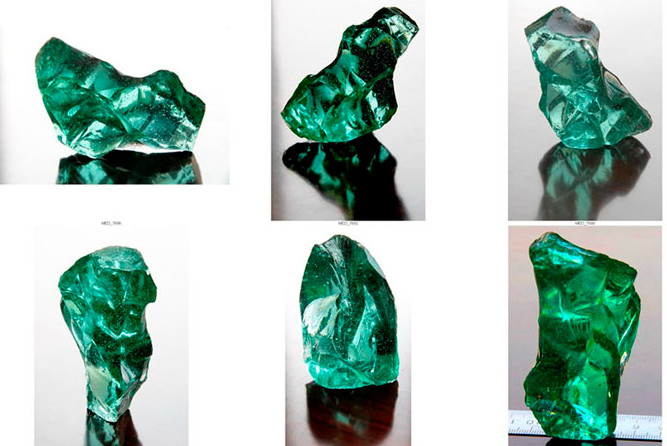Meteors bring blue stones like emeralds to Earth
The blue stone that resembles emeralds may have come to Earth through the largest meteorite explosion in human history.
According to The Siberian Times, semi-transparent stones are found deep in coniferous forest on the slope of the Metlyakovka river flowing into the Kan River in Krasnoyarsk city, Russia. Depending on the light, it is green, blue and orange.
The historian and geologist Lidiya Korshunova said her husband found the stone while climbing the mountain with you almost 4 years ago. At first, Korshunova's husband thought it was an artificial glass derived from the nearby abandoned mine and placed the stone in an aquarium for decoration.

Blue-green stone originated from outer space.(Photo: Lidiya Korshunova).
After reading the article of the geochemist and mineralogist Vladimir Vernadsky, Korshunova began to suspect the origin of the stone. Analysis results show that compared to conventional glass, the stone contains 7.5 times the amount of nickel, the amount of copper is 6 times higher, the amount of zinc is 20 times larger, the amount of cobalt is three times larger, the amount of titanium is larger. 3 times and the amount of chrome is 40 times greater. Korshunova cheats stones not artificial products.
The same amount of minerals is also found in tektite minerals, making some stones green. They formed when the melting debris of a meteor bombardment scattered in the air.
Evgeny Dmitriev, a former expert at the Russian Space Agency, said that the stone to Earth via Tunguska meteorite, exploded on June 30, 1907 in Siberia and flattened the 2,000-square-kilometer area. This meteorite explosion is considered to be the largest in human history when it destroyed 80 million old trees. The position of the stone is found 670km from Tunguska center. It is on display in the town of Zelenogursk and named Kanskit by the name Kan River.
- Discover gems similar to diamonds and emeralds
- Find 5,000 carat emeralds in Russia
- Meteors can bring life first to Earth
- Living in fear because of finding nearly 7,000 billion precious stones
- Meteors bring 'the origin of life' to Earth
- The meteorite that cleans humanity is just a matter of time.
- How to bring Martian stones to Earth?
- Meteors created the oldest rocks of the Earth
- NASA continues to hunt for dangerous meteors
- America uses nuclear weapons to protect the Earth from meteors
- Giant meteors are about to destroy the Earth
- 'Amulet' blue stone in Egyptian mummy
 Van Allen's belt and evidence that the Apollo 11 mission to the Moon was myth
Van Allen's belt and evidence that the Apollo 11 mission to the Moon was myth The levels of civilization in the universe (Kardashev scale)
The levels of civilization in the universe (Kardashev scale) Today Mars, the sun and the Earth are aligned
Today Mars, the sun and the Earth are aligned The Amazon owner announced a secret plan to build a space base for thousands of people
The Amazon owner announced a secret plan to build a space base for thousands of people